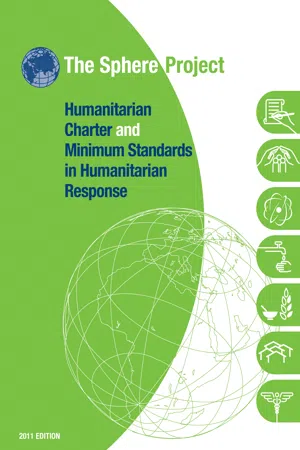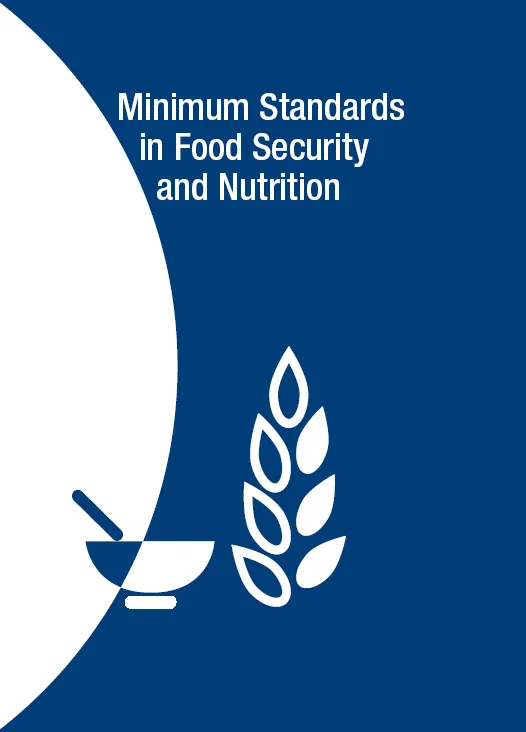![]()
How to use this chapter
This chapter is divided into four main sections:
Food security and nutrition assessment
Infant and young child feeding
Management of acute malnutrition and micronutrient deficiencies
Food security
The fourth section, food security, is subdivided into three sections: food security – food transfers; food security – cash and voucher transfers; and food security – livelihoods.
The Protection Principles and Core Standards must be used consistently with this chapter.
Although primarily intended to inform humanitarian response to a disaster, the minimum standards may also be considered during disaster preparedness and the transition to recovery activities.
Each section contains the following:
Minimum standards: These are qualitative in nature and specify the minimum levels to be attained in humanitarian response regarding the provision of food and nutrition.
Key actions: These are suggested activities and inputs to help meet the standards.
Key indicators: These are ‘signals’ that show whether a standard has been attained. They provide a way of measuring and communicating the processes and results of key actions; they relate to the minimum standard, not to the key action.
Guidance notes: These include specific points to consider when applying the minimum standards, key actions and key indicators in different situations. They provide guidance on tackling practical difficulties, benchmarks or advice on priority issues. They may also include critical issues relating to the standards, actions or indicators, and describe dilemmas, controversies or gaps in current knowledge.
If the required key indicators and actions cannot be met, the resulting adverse implications for the affected population should be appraised and appropriate mitigating actions taken.
Appendices include checklists for assessments, guidance on measuring acute malnutrition and determining the public health significance of micronutrient deficiencies and nutritional requirements. A select list of references, which points to sources of information on both general issues and specific technical issues and is divided into source material and further reading, is also provided.
Contents
Introduction
1. Food security and nutrition assessment
2. Infant and young child feeding
3. Management of acute malnutrition and micronutrient deficiencies
4. Food security
4.1. Food security – food transfers
4.2. Food security – cash and voucher transfers
4.3. Food security – livelihoods
Appendix 1: Food security and livelihoods assessment checklists
Appendix 2: Seed security assessment checklist
Appendix 3: Nutrition assessment checklist
Appendix 4: Measuring acute malnutrition
Appendix 5: Measures of the public health significance of micronutrient deficiencies
Appendix 6: Nutritional requirements
References and further reading
Introduction
Links to the Humanitarian Charter and international law
The minimum standards for food security and nutrition are a practical expression of the shared beliefs and commitments of humanitarian agencies and the common principles, rights and duties governing humanitarian action set out in the Humanitarian Charter. Founded on the principle of humanity, and reflected in international law, these principles include the right to life with dignity, the right to protection and security, and the right to receive humanitarian assistance on the basis of need. A list of key legal and policy documents that inform the Humanitarian Charter is available for reference in Annex 1 (see Click here), with explanatory comments for humanitarian workers.
Although states are the main duty-bearers with respect to the rights set out above, humanitarian agencies have a responsibility to work with the disaster-affected population in a way that is consistent with these rights. From these general rights flow a number of more specific entitlements, including the rights to participation, information and non-discrimination that form the basis of the Core Standards as well as the specific rights to water, food, shelter and health that underpin these and the minimum standards in this Handbook.
Everyone has the right to adequate food. This right is recognised in international legal instruments and includes the right to be free from hunger. When individuals or groups are unable, for reasons beyond their control, to enjoy the right to adequate food by the means at their disposal, states have the obligation to ensure that right directly. The right to food implies the following obligations for states:
‘To respect existing access to adequate food’ requires states parties not to take any measure that results in the prevention of such access.
‘To protect’ requires measures by the state to ensure that enterprises or individuals do not deprive individuals of access to adequate food.
‘To fulfil’ (facilitate) means that states must proactively engage in activities intended to strengthen people’s access to and utilisation of resources and means to ensure their livelihoods, including food security.
In the case of disasters, states should provide food to those in need or may request international assistance if their own resources do not suffice. They should also facilitate safe and unimpeded access for international assistance.
The Geneva Conventions and additional protocols include the right to access to food in situations of armed conflict and occupation. It is prohibited to starve civilians as a method of warfare and to attack, destroy, remove or render useless foodstuffs, agricultural areas for the production of foodstuffs, crops, livestock, drinking water installations and supplies, and irrigation works. When one state occupies another by force, international humanitarian law obliges the occupying power to ensure adequate food for the population and to bring in necessary supplies if the resources of the occupied territory are inadequate. States should make every effort to ensure that refugees and internally displaced persons have access at all times to adequate food.
The minimum standards in this chapter reflect the core content of the right to food and contribute to the progressive realisation of this right globally.
The importance of food security and nutrition in disasters
Access to food and the maintenance of an adequate nutritional status are critical determinants of people’s survival in a disaster (see The place of Sphere within humanitarian action, click here). The people affected are often already chronically undernourished when the disaster hits. Undernutrition is a serious public health problem and among the lead causes of death, whether directly or indirectly.
The causes of undernutrition are complex. The conceptual framework (see Click here) is an analytical tool that shows the interaction between contributing factors to undernutrition. The immediate causes of undernutrition are disease and/or inadequate food intake, which result from underlying poverty, household food insecurity, inadequate care practices at household or community levels, poor water, hygiene and sanitation, and insufficient access to healthcare. Disasters such as cyclones, earthquakes, floods, conflict and drought all directly affect the underlying causes of undernutrition. The vulnerability of a household or community determines its ability to cope with exposure to these shocks. The ability to manage the associated risks is determined largely by the characteristics of a household or community, particularly its assets and the coping and livelih...









